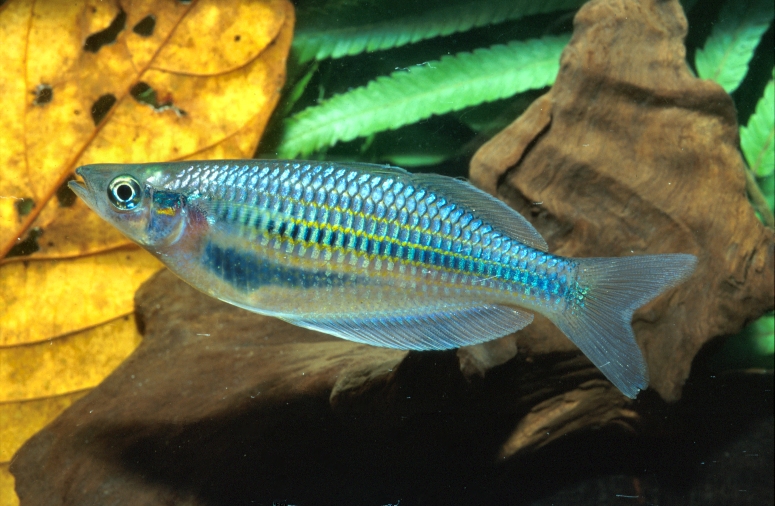|
 |
Melanotaenia batanta [Warey River]- photo© Gerald Allen |
Allen and Renyaan, 1998
Batanta Rainbowfish
Species Summary
Melanotaenia batanta has an overall blue body colouration with darker scale margins. Lower half of body whitish to silvery with a triangular grey area on the lower side, above the pelvic fins. Narrow orange stripes are visible between each horizontal scale row on the upper two-thirds of side. A dark blotch consisting of a concentration of melanophores immediately behind eye on uppermost part of operculum. Fins mainly translucent except dorsal, anal, and caudal, frequently with bluish tint. There is little difference between male and female, an unusual feature for rainbowfishes. Males may reach a maximum size of 10 cm, but females are usually less than 8 cm.
Melanotaenia batanta is related to M. fredericki and M. irianjaya. The trio are restricted to the Birdshead (Vogelkop) Peninsula at the western extremity of New Guinea. M. irianjaya occurs in southern drainages flowing into Bintuni Bay whereas M. fredericki occupies the westernmost portion of the peninsula and nearby Salawati Island. The three species have a similar body shape and unlike most Melanotaenia there is a lack of pronounced sexual dimorphism. Males, in particular, lack the pronounced elongation of the posterior dorsal and anal fin rays, but rather the anterior or middle rays tend to be longest. Moreover, the three species have poorly developed palatine teeth or lack them entirely. M. irianjaya is easily distinguished by the narrow dark margins on the upper and lower edges of the caudal fin lobes. It also usually has fewer anal fin rays than M. batanta. Melanotaenia batanta is most closely related to M. fredericki, but there is a modal difference in number of dorsal fin rays and it possesses fewer cheek scales (11-13 vs. 17-20).
Distribution & Habitat
Known only from Batanta Island in the Raja Ampat Islands lying immediately west of the Vogelkop Peninsula, West Papua. Batanta Island is home to three separate species of rainbowfishes. Melanotaenia batanta were collected from Warmon Creek, on the northern side of the island. The rainbowfish was restricted to a very small portion of this stream, essentially a 400 metre stretch bounded by brackish mangrove habitat and a 10 metre high waterfall upstream. Collections above the falls yielded mainly sicydiine gobies (noted for their climbing ability) and no rainbowfishes. The stream was clear and moderately fast-flowing through primary rainforest.
Raja Ampat, literally translated to mean "the four kings", is a group of islands comprising Waigeo, Batanta, Salawati and Misool located to the west of Sorong, on the northwest tip of the main island of New Guinea. The Raja Ampat Islands are situated immediately west of the West Papuan mainland, between 0°20' and 2°15' S latitude, and 129°35' and 131°20' E longitude. The Archipelago and surrounding seas occupy approximately 40,000 km².
Batanta is a large, narrow island characterised by numerous deep bays and irregular-shaped islets along its northern shore. It is approximately 55 kilometres long and 30~35 kilometres wide. The terrain consists mainly of steep limestone hills and mountains covered by undisturbed rainforest. There are at least six small rivers on the northern side, which, invariably drain into a narrow, but well-developed mangrove zone. The southern portion of the island is generally steeper than the north and lacks large streams. There is little mangrove on this side and the rainforest essentially extends to the edge of the sea.
.Warmon Creek.Pouyaud.jpg) |
Melanotaenia batanta [Warmon Creek] - photo© Laurent Pouyaud |
Remarks
This species was named batanta, with reference to the type locality. No live specimens have so far been collected for the aquarium hobby. This species should not be confused with another rainbowfish distributed in the hobby as the Batanta Island Rainbowfish.
Literature
Allen G.R. & S.J. Renyaan (1998) Three new species of rainbowfishes (Melanotaeniidae) from Irian Jaya, Indonesia. Aqua, Journal of Ichthyology and Aquatic Biology 3(2): 69-80.
Adrian R. Tappin
Updated April, 2013



|
|

